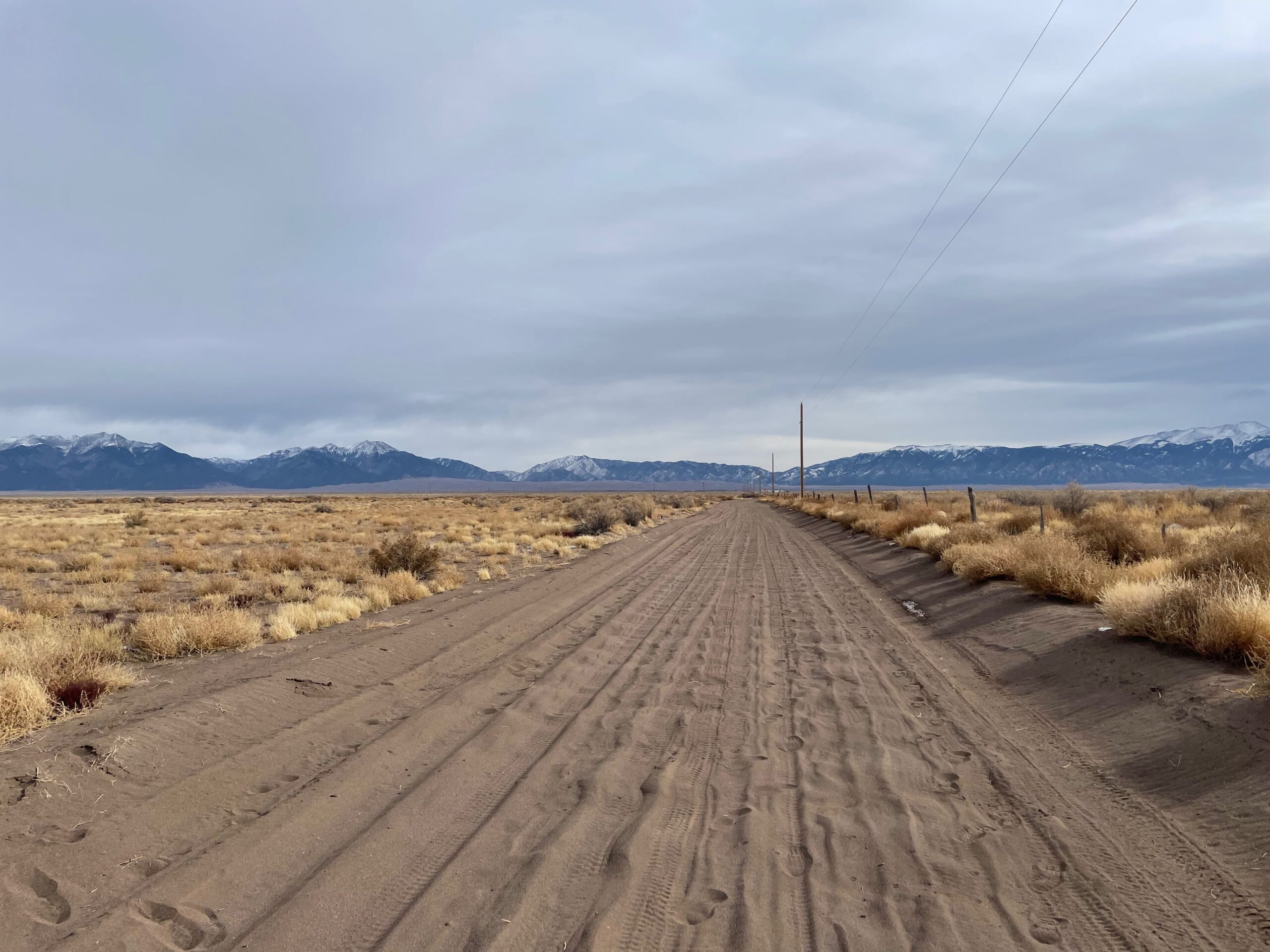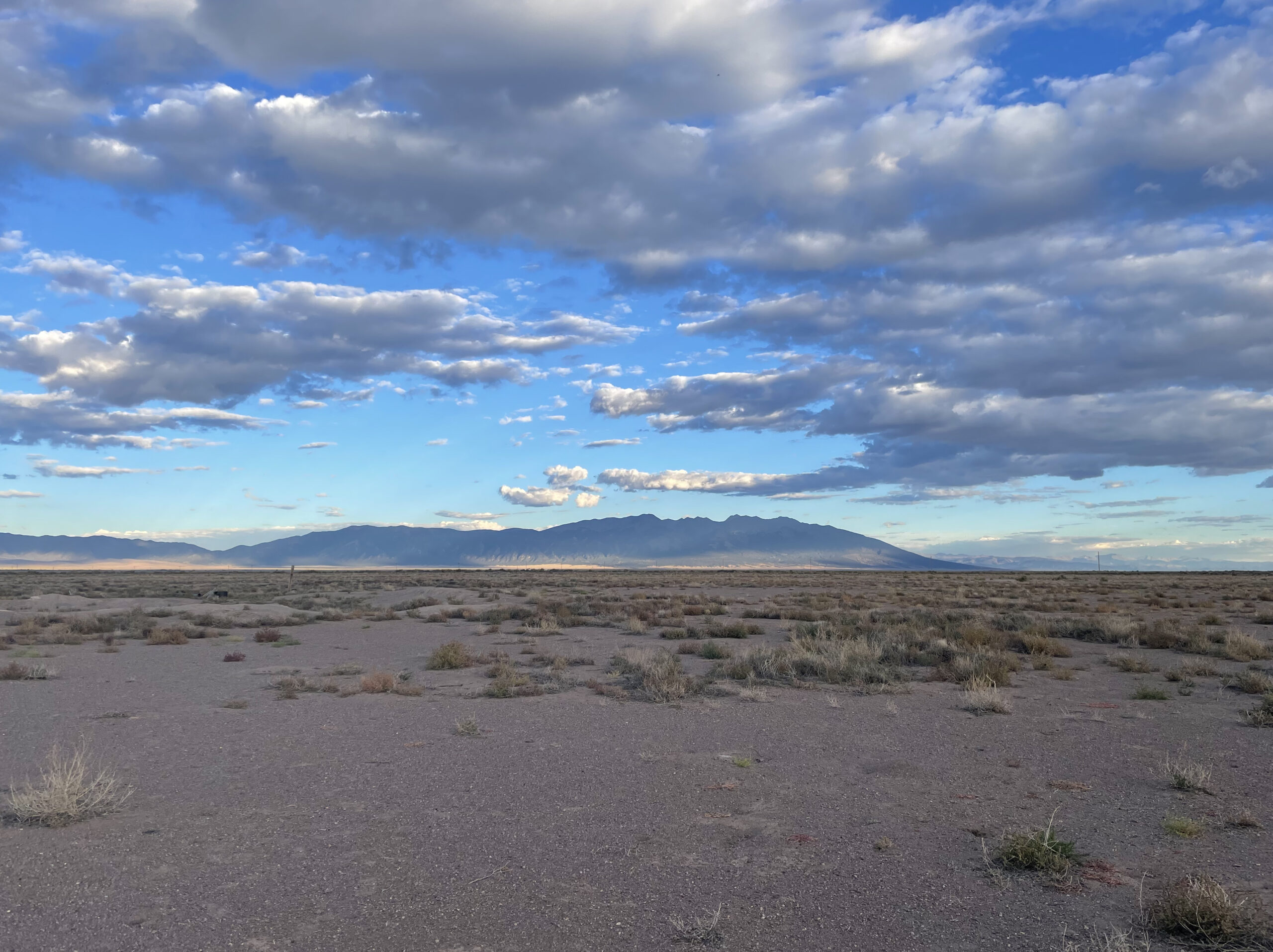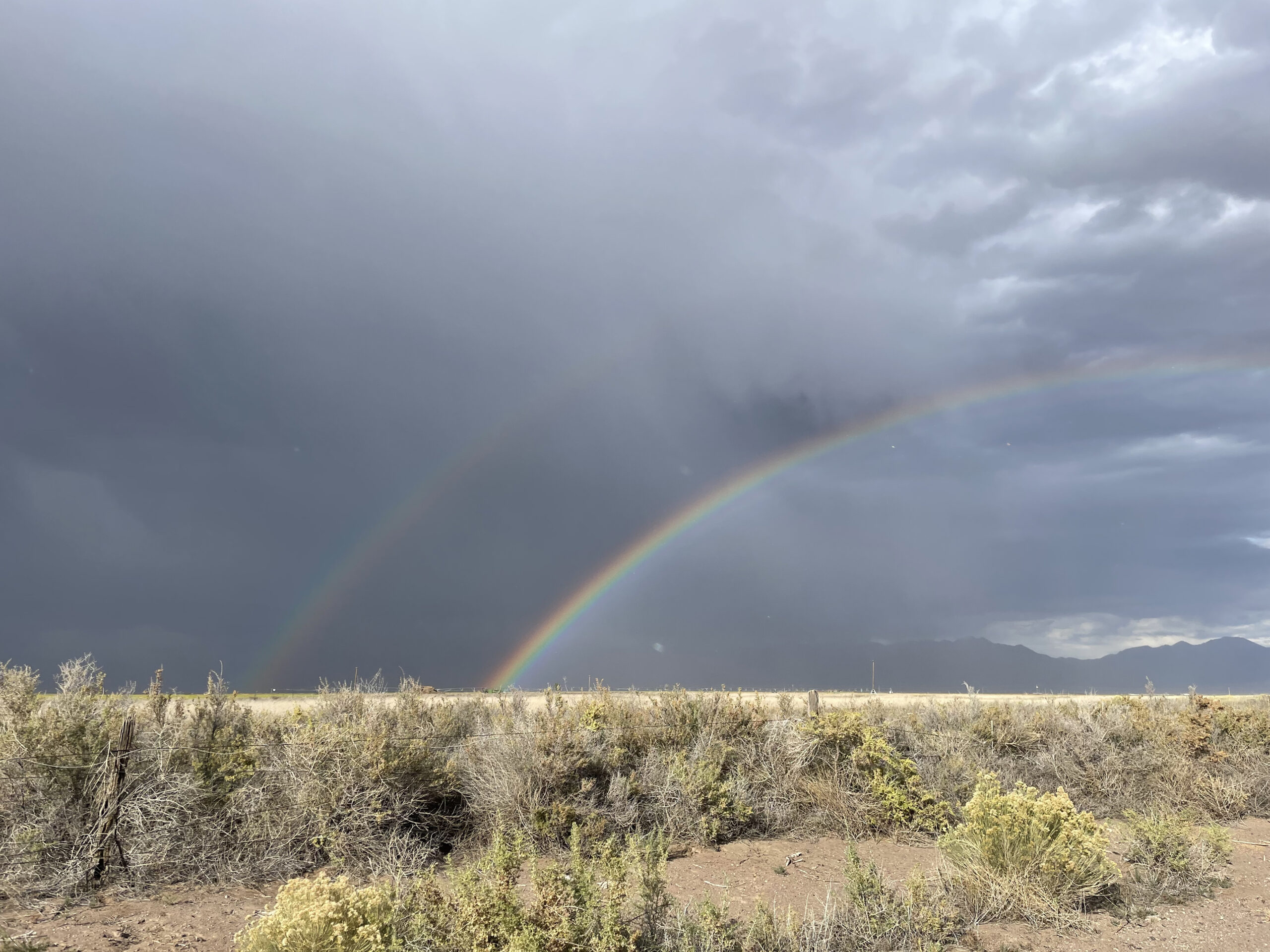Exclusive: Marguerite Humeau Reveals ‘Orisons,’ A New Earthwork Opera In The Desert
November 29, 2022

Through her work, multi-disciplinary artist Marguerite Humeau often tests the boundaries of biology, history, technology, and consciousness. Humeau is an obsessive researcher, and her projects reflect thousands of hours of conversations with hundreds of collaborators, many of whom are scientists, historians, and, most importantly, keepers of oral histories, mythologies, and bodies of knowledge that have been considered marginal. Humeau has previously reanimated scenes of animal mourning, resurrected the spirit of Cleopatra, looked for the revenge of the sphinx on humankind, and reexamined the relationship between trance and the precepts of civilization.
Her next project, Orisons, is a different kind of work. This earthwork combines her practice of speculative fiction within a naturally occurring ecosystem: a plot of land in an Alpine Desert of San Luis Valley in Colorado’s Rocky Mountains. The ambitious project looks to amplify the presence of living and non-living physical, historical, spiritual, and mythological beings on the site. Rain spoke with Humeau about the momentous beginning of this historical and impactful work.

Satellite image of the San Luis Valley, Colorado, exported from Google Earth Pro
Year: 2022. Image Credit: Google Earth Pro. Location coordinates 37.735867, -105.836213, Access date 1 September 2022. Courtesy of the artist
History of land art
Mark Benjamin: We have previously shared one of your prominent projects with our readers, and we are looking forward to your new earthwork project, Orisons in collaboration with the nomadic art museum Black Cube. Can you tell us more about it?
Marguerite Humeau: It started as a speculative earthwork with the nomadic art museum Black Cube, headquartered in Denver, Colorado. Through their artist fellowship program, they support artists to produce site-specific artwork anywhere in the world. The journey has been incredible because it has made me think about what it means to create land art today. Starting this project, I was thinking in a much more traditional way regarding how the work sat in the greater history of land art. All these assumptions… like the work should be something you should be able to see from the sky, or if you were in space, you should be able to see it too.
And then, as we were making further progress, I thought that I wanted my work to be about our current relationship to the environment as humans on Earth, that is, touching the land as little as possible physically (almost to the point that the artistic or poetic intervention becomes invisible), yet creating an impactful artwork that would be intensifying, supporting and celebrating, the presence of all living, decaying, dead, or dormant beings on the site, physical, historical, spiritual and mythological beings.

Title: On Orisons (Dried Spurge)
Holes in the Orisons ground Year: 2022
Materials: Photograph
Image Credit: Marguerite Humeau, Courtesy of the artist.
Orisons
What is our place in our landscapes and ecosystems today?
I have been thinking a lot about this idea of a post-climate world that this land embodies because it has been in a constant drought for the past couple of years. During my first site visit, I was talking to the farmers who are letting us use the site for “Orisons,” the Jones family who owns and operates Jones Farms Organics. It was emotional for me to discuss with them because they were discussing the drought and changing climate and how it is starting to impact their lives. So, I started to think about this post-climate world where climate change has already occurred, and maybe humans are forced to migrate and can't live on the land anymore. Since then, I have been obsessed with creating artwork that could act as a mirage, dream, or offering, a gift to the local human and non-human communities.

Title: Satellite image of the San Luis Valley, Colorado (detail), exported from Google Earth Pro
Year: 2022
Image Credit: Google Earth Pro.
Location coordinates 37.730703, -105.982856, Access date 1 September 2022.
Courtesy of the artist
Transcendence
I was also thinking, what are all these “weeds”? What are all these growing plants that people consider to be “invasive”? Perhaps we could look at them more like superheroes because they've already adapted to this new climate with extreme conditions. They live and thrive there with barely any water. And then, at the same time, I thought about how humans should transcend our ecosystems. We must transcend and merge with the greater whole of life because life will survive us. There is life in volcanoes in Antarctica; life can survive in extreme conditions. So, I thought that maybe conceptually and spiritually, we need to think about what happens when we merge and become part of a more significant concept, life, as an extension of our condition as a human species.
Maybe today, the ultimate piece of land art is invisible. And perhaps it's about amplifying all the presences already there and becoming part of this a bit more. So, in “Orisons,” we humans are becoming a flock of birds (we are invited to lie down on the wide-open wings of a sculptural bird family that is flying low above the ground) to transcend, relax, and just look at where we are, somewhere between the sky and the earth, on the horizon line. The opera, made of wind-activated instruments recreating the sound of a rainstorm, amplifies the voices of all these “weeds,” which are usually despised and doomed “invasive,” but that you are here and surviving and magically expanding, living, and dancing in this harsh environment.

Title: Holes in the Orisons ground Year: 2022
Materials: Photograph
Image Credit: Marguerite Humeau, Courtesy of the artist
The landscape
What is the vision for this piece of land in the San Luis Valley of Colorado? You mentioned that you don't want to disturb anything on the land. Are you going to be changing something in this plot of land?
It's an interesting question. Yes, it's been a long process. I came up with over five, six, or maybe ten proposals. In the beginning, it was much more of an earthwork, and I was trying to see how we could retain more water by shaping the earth on the land. I always had a vision and was interested in retaining the rain. How to create a mirage, a vision of water, thinking that is one of the local land and communities' greatest need and desire. How do we make rain appear, physically or mentally? Like something you dream about so much that it becomes visible.

Materials: black ink on paper Dimensions: 21 x 29.7cm
Image Credit: Marguerite Humeau, Courtesy of the artist
It was clear that I didn't want to disturb the landscape. I wanted to go for a much lighter touch. I wanted to celebrate what was already there. So, I created an opera made of wind-activated instruments, each based on specific “weeds” found on the site. Each device has its own character. All make unique percussive sounds reminiscent of a rainstorm but also abstract enough that they are evocative of irregular rhythms, the rhythms of each unique individual living on the site. Ironically, the circles and their pivot irrigation systems look like clocks when seen from the sky. Quartz is a recent invention and a completely artificial way of giving rhythms to our lives. How can we celebrate the many rhythms of all the different types of life on the land?
Ghost maps





Ghost map I: I drew: the traces of deer seen from satellites forming constellations. Have deers been drawing stars? I drew: holes and tiny leg footprints I observed on the land's surface. I drew: imagined burrows of voles, pocket gophers, ground squirrels, and prairie dogs. The golden light, the fatigued soil, eroded and depressed (variations). Traces of machinery observed from satellites—other traces of unidentified presence. Ghost map II, I drew: the circle, ghosts of pivot irrigation systems and their circular motions, and wounds. Ghost map III, I drew: the darkness of an industrial past, eroded soils, and memory of the golden light and its variations. The memory of light. The sunset, flying seeds. Dormant seeds. I drew vulnerable and healing plants and plants oracles. The plants some call “weeds” may already live in the future.
Nomads, Russian Thistle, Tumble Pigweed, Tumble Ringwing, Burning Bush. Resilient living forms, Russian Knapweed, Canada, Mountains, and Platte Thistle. Rain dancers, Spurge, Japanese brome, Spike Bentgrass, Canadian Horseweed. Body parts, blood vessels, Nodding Buckwheat, skeletons, Douglas’s Knotweed, American Bugseed, and Greasewood. Ghost map IV, I drew: the entanglement of a turquoise stone, bird tears, and a raindrop. Past and future rain-making songs and dances, thunderbirds flapping their wings, the ghosts of sandhill cranes which don’t come anymore ... ancient human communities, goat hair, silver, feathers. Ghost map V, Past rain, future droughts, present drought, past winds, ancient storms, predictions from the sky. Dark sky and shiny stars.
Year: 2022
Materials: Pigments and water on paper
Dimensions: 66 cm x 101.7 cm
Image Credit: Marguerite Humeau
Courtesy of the artist

Title: On Orisons (Sand Dunes)
Year: 2022
Materials: Photograph
Image Credit: Courtesy of the artist and Black Cube Nomadic Art Museum

Title: Driving to Orisons (Double Rainbow)
Year: 2022
Materials: Photograph
Image Credit: Courtesy of the artist and Black Cube Nomadic Art Museum
Opera
That's remarkable. Can you tell us a little more about the choir you're making?
I'm extracting specific parts from each “weed” I foraged on the site. I am using microscopic features of each and scaling them up and transforming these parts into wind-activated instruments that each have their character. This opera will recreate the sound of a rainstorm. As one of my multiple references, I was inspired by a video on YouTube of a human choir. They were recreating a rainstorm with their bodies (hands, voice, jumping, etc.). So I analyzed the sequences and various nuances to understand what makes a rainstorm or how to evoke rain, the different moments of a rainstorm, and how it builds up.
This choir was incredible. I was almost in tears. I created different groups in my opera, different types of instruments based on various “weeds” found on the land; some of them are making subtle sounds of raindrops, some of them are making more resounding echoes or raindrops, abstracted rhythms, and then there is a series of birds inspired by the sandhill cranes, that are like flutes spinning in the wind and are also trying to synchronize together. Their sound is based on an abstracted sound of the actual Sandhill cranes that migrate above the site twice a year. Each flute recreates a note extracted from a song of a sandhill crane. It's going to be an opera made of all these different characters. My next step was, how do we watch or experience the opera as humans? We need to merge with the land. We need to connect with the biosphere. We will become those birds, so when we come to the land, we will encounter giant abstracted birds on which wings you are invited to lie down, and you can go and experience the land or listen to the opera.
Recently, we have also been consulting a geobiologist, an energy healer. I wanted to ensure that I would place the instruments and the bird family in the most meaningful and relevant spots, so they can heal the land, help it free itself from its sadness perhaps, or care for it. He talked to us about different human groups who had been trying to live on the land in the past, and I will also get further consultation about which materials would be more relevant. The instruments will be the size of the local plants (almost like miniature sculptures), so they completely fade into the land. I want them to be intensely charged to have a meaningful and tangible impact on the ground and its inhabitants.

Title: Driving to Orisons
Year: 2022
Materials: Photograph
Image Credit: Courtesy of the artist and Black Cube Nomadic Art Museum
One of the highest deserts in the world
Let's talk a little bit more about the land. It's in the Alpine desert, which we heard is an extraordinarily old land. Can you tell us a little more about it?
Yes, so it is a desertic area. It is one of the highest deserts in the world. First, the trip from Denver to the San Luis Valley is an epic and cosmic journey. When you finally enter the valley, it feels like stepping into another world. You see the Rocky Mountains on the horizon. You can also see the famous Great Sand Dunes National Park formed over time with the force of the extreme winds in the area. I wanted to collaborate with the wind because it is so present on the site, and the wind can be destructive but can also be an active agent of transformation. So, the wind created the dunes by blowing all the sand against the Rocky Mountains. It's incredible to witness. You have these mountains, and then they morph into becoming a dune. So, you see, that's also just behind the site.
When arriving at the site, you are welcomed by an ancient structure that was used for cattle. You are immediately drawn to the dunes opposite the site's entrance. You may encounter… a tumbleweed graveyard, tumbleweeds dancing and flying through the site, red ant mounds, burrows, tiny circles maybe formed by agricultural machinery, adobe patches, creating alien landscapes within the landscape, a double rainbow, large bushes, spurges, sand and rabbits, deer, beetles, the ancient traces of the pivot irrigation system forming ley lines-like arks on the site, remnants of water pipes, a concrete pad in the center, a lot of wind, shiny stars at night, voles, tiny leg footprints, pocket gophers, prairie dogs, the golden light, eroded soil, Russian Thistle, Tumble Pigweed, Tumble Ringwing, Burning Bush, resilient living forms, Russian Knapweed, Canada, Mountains, and Platte Thistle. Rain-dancers, Spurge, Japanese Brome, Spike Bentgrass, Canadian Horseweed, body parts, blood vessels, Nodding Buckwheat, entire skeletons, dispersed, Douglas’s Knotweed, American Bugseed and Greasewood, turquoise stones, bird tears, songs in the wind, feathers, ancient storms, future droughts, earth hugs.
The work is the land, and everyone and everything living on it, breathing on it, has been on it, will be on it, material or immaterial, physical or mythical. I'm not creating an ecosystem. I'm just showing you the ecosystem that is there, that was there, and that may be there. So yes, we have a two-year lease. Hopefully, it will become permanent work, but we are committing to the display for two years to see how it goes.

Title: On Orisons (Nodding Buckwheat)
Year: 2022
Materials: Photograph
Image Credit: Marguerite Humeau, Courtesy of the artist
Frontier Drive-Inn
Are there any other projects on your site?
There is a project not far from our site in the San Luis Valley called the Frontier Drive-Inn. For its opening, they invited experimental architect Ron Rael to design an architectural commission – eight open-air observatories entirely 3D printed in adobe. They also have a giant screen and show films. We were there with Black Cube (commissioner of “Orisons”) for the harvest festival party, and it was extraordinary to gather with all members of the local community to support the San Luis Valley Local Foods Coalition. I look forward to visiting again when we install the work and for the opening.
So, it seems like this project is similar to your past body of work. Do you agree that there are similarities?
Absolutely. It is expanding from a similar conceptual starting point and pushing new ground, leaving uncharted territories. I usually start by positing a hypothesis, a “what if?” scenario, raising a question or enigma connected to human existence about what we could be, how did we evolve, what have been the tilting points, how we could live on Earth, and how we co-exist with other species, humans and non-humans communities. "Orisons" has been a pivotal project because I have been looking to develop ideas (and, subsequentially, forms, systems, or stories…) firmly grounded in specific sites. I mean, with every project, I want to start from scratch again, and I feel “Orisons” has been an exciting transition. So, while developing work anchored in the rest of my body of work, this year has also been a formal departure from the work I have done previously.
A part of a body of work
What project would you say it connects explicitly to?
It connects to all my work, and maybe there is a direct connection to my first project, “The Opera of Prehistoric Creatures.” I was trying to resurrect the chants of prehistoric creatures by recreating their vocal tracts. I then gave them a “brain,” an AI that was helping them to evolve again in our contemporary era. Orisons are like giving a voice to the extinct. Here in Colorado, I'm sharing a voice to the plant species we've called “invasive,” to the mythological beings of the past and the present and the future, to all the beings that have lived on the land or will in the future, I am giving a voice to the invisible, the beings that have become extinct in our mental landscapes.
We are so excited about the opening. Do you have an opening date yet?
Orisons will open at the end of June 2023. To keep up with the opening date and everything related to the artwork, follow Black Cube on Instagram or sign up for their newsletter at www.blackcube.art. It’s so special there, and it will be really fun. You should come!

